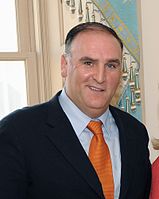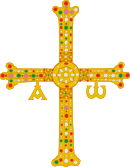Asturias
Asturias
Asturies(Asturian) | |
|---|---|
| Principado de Asturias(Spanish) Principáu d'Asturies(Asturian) Principao d'Asturias(Galician–Asturian) | |
| Motto(s): Hoc signo tuetur pius, Hoc signo vincitur inimicus[1] ( "By this sign is the pious safeguarded. By this sign is the enemy conquered." ) | |
| Anthem:Asturias, patria querida(Spanish) "Asturias, beloved homeland" | |
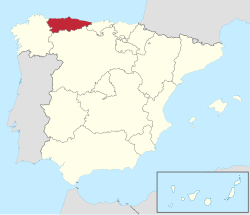 Location of Asturias (red) within Spain | |
| Coordinates:43°21′41″N5°50′52″W/ 43.36139°N 5.84778°W | |
| Country | Spain |
| Formation | 722 (Kingdom of Asturias) 1230 (Comarca of the Asturias of Oviedo) 1833 (Province of Oviedo) 1982 (Autonomous Community) |
| Statute of Autonomy | 1981 |
| Capital Largest city | Oviedo Gijón |
| Government | |
| • Type | Devolved governmentin aconstitutional monarchy |
| • Body | Government of the Principality of Asturias |
| •President | Adrián Barbón(FSA-PSOE) |
| • Legislature | General Junta of the Principality of Asturias |
| •Congress of Deputies | 7 Deputies (of 350) |
| •Senate | 6 Senators (of 265) |
| Area | |
| • Total | 10,604 km2(4,094 sq mi) |
| • Rank | 10th in Spain(2.1%) |
| Population (2021)[2] | |
| • Total | 1,011,792 |
| • Rank | 14th in Spain(2.4%) |
| • Density | 95/km2(250/sq mi) |
| Demonym(s) | Asturian asturiano, -na(es) |
| GDP | |
| • Total | €25.822 billion (2022) |
| • Per capita | €25,675 (2022) |
| Time zone | UTC+1(CET) |
| Area code | +34 985 |
| ISO 3166 code | ES-AS (autonomous community) ES-O (province) |
| HDI(2021) | 0.900[4] very high·9th |
| Official languages | Spanish(Asturianhas special status[5]) |
| Patron saint | Our Lady of Covadonga |
| Website | asturias.es |
 | |
Asturias(/æˈstʊəriəs,ə-/,[6][7]Spanish:[asˈtuɾjas];Asturian:Asturies[asˈtuɾjes;-ɾjɪs]) officially thePrincipality of Asturias,(Spanish:Principado de Asturias;Asturian:Principáu d'Asturies;Galician–Asturian:Principao d'Asturias) is anautonomous communityin northwestSpain.
It is coextensive with theprovinceof Asturias and contains some of the territory that was part of the largerKingdom of Asturiasin theMiddle Ages.Divided into eightcomarcas(counties), the autonomous community of Asturias is bordered byCantabriato the east, byLeón(Castile and León) to the south, byLugo(Galicia) to the west, and by theCantabrian seato the north.
Asturias is situated in a mountainous setting with vast greenery and lush vegetation, making it part ofGreen Spain.The region has amaritime climate.It receives plenty of annual rainfall and little sunshine by Spanish standards and has very moderated seasons, most often averaging in the lower 20scelsius.Heatwaves are rare due to mountains blocking southerly winds. Winters are very mild for the latitude, especially near sea level.
The most important cities are the communal capital,Oviedo,the seaport and largest cityGijón,and the industrial town ofAvilés.Othermunicipalities in AsturiasincludeCangas de Onís,Cangas del Narcea,Gozón,Grado,Langreo,Llanera,Laviana,Lena,Llanes,Mieres,Siero,Valdés,VegadeoandVillaviciosa(see alsoList of municipalitiesandcomarcas in Asturias).
History[edit]


Asturias was inhabited first byHomo erectus,then byNeanderthals.Since theLower Paleolithicera, and during theUpper Paleolithic,Asturias was characterized by cave paintings in the eastern part of the area. In theMesolithicperiod, a native culture developed, that of theAsturiense,and later, with the introduction of theBronze Age,megalithsandtumuliwere constructed. In theIron Age,the territory came under the cultural influence of theCelts;the local Celtic peoples, known as theAstures,were composed of tribes such as theLuggones,thePesicos,and others, who populated the entire area withcastros(fortified hill-towns). Today theAsturCeltic influence persists inplace names,such as those of rivers and mountains.
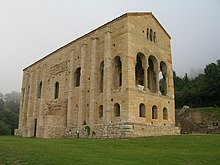
With the conquest of Asturias by theRomansunderAugustus(29–19 BC), the region entered into recorded history. The Astures were subdued by the Romans, but were never fully conquered. After several centuries without foreign presence, they enjoyed a brief revival during the Germanic invasions of the late 4th century AD, resistingSuebiandVisigothraids throughout the 5th century AD, ending with theMoorish invasion of Spain.However, as it had been for the Romans and Visigoths, the Moors did not find mountainous territory easy to conquer, and the lands along Spain's northern coast never became part ofIslamic Spain.With the beginning of the Moorish conquest in the 8th century, this region became a refuge for Christian nobles, and in 722, ade factoindependent kingdom was established, theRegnum Asturorum,which was to become the cradle of the incipientReconquista(Reconquest).
In the 10th century, the Kingdom of Asturias gave way to theKingdom of León,and during theMiddle Agesthe geographic isolation of the territory made historical references scarce. Through the rebellion of Prince Henry (the laterHenry II of Castile) in the 14th century, the Principality of Asturias was established. The most famous proponents of independence were Gonzalo Peláez andQueen Urraca,who, while achieving significant victories, were ultimately defeated byCastiliantroops. After its integration into theKingdom of Spain,Asturias provided the Spanish court with high-ranking aristocrats and played an important role in the colonisation of America. Since 1388, the heir to the Castilian (later Spanish) throne has been styledPrince (or Princess) of Asturias.In the 16th century, the population reached 100,000 for the first time, and within another century that number would double due to the arrival of Americancorn.

In the 18th century, Asturias was one of the centres of theSpanish Enlightenment.The renownedGalicianthinkerBenito de Feijóosettled in theBenedictineMonasteryofSan Vicente de Oviedo.Gaspar Melchor de Jovellanos,apolymathand prominent reformer and politician of the late 18th century, was born in the seaside town ofGijón.
During theNapoleonic Wars,Asturias was the first Spanish province to rise up against the French following the abdication of KingFerdinand VIIon 10 May 1808. Riots began in Oviedo and on 25 May the local government formally declared war onNapoleonwith 18,000 men called to arms to resist invasion.[9]
TheIndustrial Revolutioncame to Asturias after 1830 with the discovery and systematic exploitation of coal mines and iron factories at themining basinsofNalónandCaudal.At the same time, there was significant migration tothe Americas(especiallyArgentina,Uruguay,Puerto Rico,CubaandMexico); those who succeeded overseas often returned to their native land much wealthier. These entrepreneurs were known collectively asIndianos,for having visited and made their fortunes in theWest Indiesand beyond. The heritage of these wealthy families can still be seen in Asturias today: the region is dotted with many largemodernistavillas, as well as cultural institutions such as free schools and public libraries.

Asturias played an important part in the events that led up to theSpanish Civil War.In October 1934, Asturian miners and other workers staged an armed uprising (seeRevolution of Asturias) to oppose the coming to power of theright-wing CEDAparty, which had obtained three ministerial posts in the centralist government of theSecond Spanish Republic.For a month, a Popular Front Committee exercised control in southern Asturias, while local workers committees sprang up elsewhere in the region. A defense committee led byanarcho-syndicalistsupporters took power in Oviedo. Troops under the command of a then unknown general namedFrancisco Franco Bahamondewere brought fromSpanish Moroccoto suppress the revolt. Franco applied tactics normally reserved for overseas colonies, using troops of theSpanish LegionandMoroccan troops;ferocious oppression followed.
As a result, Asturias remained loyal to the republican government during theSpanish Civil War,and was the scene of an extraordinary defence in extreme terrain, theBattle of El Mazuco.With Franco eventually gaining control of all Spain, Asturias — traditionally linked to theSpanish Crown— was known merely as the "Province of Oviedo" from 1939 until Franco's death in 1975. The province's name was restored fully after the return of democracy to Spain, in 1977. In the 50s and 60s the industrial progress of Asturias continued with the constitution of national enterprises likeEnsidesaand Hunosa, but the 80s was the decade of a dramaticindustrial restructuring.
On 30 December 1981,[10]Asturias became an autonomous community within the decentralised territorial structure established by the Constitution of 1978.Rafael Luis Fernández Álvarez,who had previously served as the President of the Regional Council since 1978, became the firstPresident of the Principality of Asturias,upon the adoption of autonomy.[10]TheAsturian regional governmentholds comprehensive competencies in important areas such as health, education and protection of the environment. The current president, elected in 2019, isAdrián Barbón(PSOE).
Administrative and territorial division[edit]
Asturias is organised territorially into 78municipalities,further subdivided intoparishes.
Asturias is also divided into eightcomarcas,which are not administrative divisions. They are only used as a system to homogenize the statistical data made by the Principality.
Municipalities of Asturias[edit]
| Rank | Name | Comarca | Pop. | Rank | Name | Comarca | Pop. | ||
|---|---|---|---|---|---|---|---|---|---|
 Gijón  Oviedo |
1 | Gijón | Gijón | 297,706 | 11 | Llanera | Oviedo | 13,792 |  Avilés  Siero |
| 2 | Oviedo | Oviedo | 205,167 | 12 | Llanes | Oriente | 13,545 | ||
| 3 | Avilés | Avilés | 75,877 | 13 | Laviana | Nalón | 12,584 | ||
| 4 | Siero | Oviedo | 51,792 | 14 | Cangas del Narcea | Narcea | 11,817 | ||
| 5 | Langreo | Nalón | 38,262 | 15 | Valdés | Eo-Navia | 11,099 | ||
| 6 | Mieres | Caudal | 36,754 | 16 | Lena | Caudal | 10,499 | ||
| 7 | Castrillón | Avilés | 22,235 | 17 | Gozón | Avilés | 10,433 | ||
| 8 | Corvera de Asturias | Avilés | 15,563 | 18 | Carreño | Gijón | 10,226 | ||
| 9 | San Martín del Rey Aurelio | Nalón | 15,505 | 19 | Aller | Caudal | 10,201 | ||
| 10 | Villaviciosa | Gijón | 14,984 | 20 | Grado | Oviedo | 9,598 | ||
Parishes[edit]
Theparroquiaor parish is the subdivision of the Asturian municipalities. Currently, there are 857 parishes integrating the 78 municipalities in the region, and they usually coincide with the ecclesiastic divisions.
Geography and climate[edit]


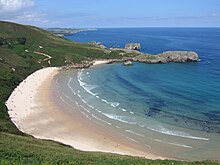

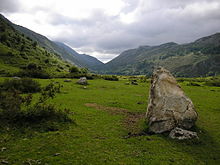
TheCantabrian Mountains(Cordillera Cantábrica) form Asturias's natural border with the province ofLeónto the south. In the eastern range, thePicos de EuropaNational Park contains the highest and arguably most spectacular mountains, rising to 2,648 metres (8,688 ft) at the Torrecerredo peak. Other notable features of this predominantly limestone range are theParque Natural de Redesin the central east, the central Ubiñas south ofOviedo,and theParque Natural de Somiedoin the west. The Cantabrian mountains offer opportunities for activities such as climbing, walking, skiing and caving, and extend some 200 kilometres (120 mi) in total, as far asGaliciaprovince to the west of Asturias andCantabriaprovince to the east. Similar opportunities are available for the interested traveler of Asturias inCaldoveiro Peak.
The Asturian coastline is extensive, with hundreds of beaches, coves and natural sea caves. Notable examples include the Playa del Silencio (Beach of Silence) near the fishing village of Cudillero (west ofGijón), as well as the many beaches surrounding the summer resort of Llanes, such as the Barro, Ballota and Torimbia (the latter a predominantlynudistbeach). Most of Asturias's beaches are sandy, clean, and bordered by steep cliffs, on top of which it is not unusual to see grazing livestock.
The key features of Asturian geography are its rugged coastal cliffs and the mountainous interior. The climate of Asturias is heavily marked by the Gulf Stream. Falling within the Cantabrian belt known asGreen Spainit has high precipitations all year round. Summers are mild and, on the coast, winters also have relatively benign temperatures, rarely including frost. The cold is especially felt in the mountains, where snow is present from October till May. Both rain and snow are regular weather features of Asturian winters. In coastal or near-coastal areas, daytime high temperatures generally average around 12 °C (54 °F) – 13 °C (55 °F) during winter and 22 °C (72 °F) – 23 °C (73 °F) in summer.[12]
| ||||||||||||||||||||||||||||||||||||||||||||||||||||||||||||||||||||||||||||||||||||||||||||||||||||||||||||||||||||||||||||||||||||||||||||||||||||||||||||||||||||||||
| ||||||||||||||||||||||||||||||||||||||||||||||||||||||||||||||||||||||||||||||||||||||||||||||||||||||||||||||||||||||||||||||||||||||||||||||||||||||||||||||||||||||||
| ||||||||||||||||||||||||||||||||||||||||||||||||||||||||||||||||||||||||||||||||||||||||||||||||||||||||||||||||||||||||||||||||||||||||||||||||||||||||||||||||||||||||
Pollution and conservation[edit]
This part of Spain is one of the best conserved in the entire country, and full of vegetation and wild spaces. It holds two of the most important natural parks in Spain, and is very renowned for the Picos de Europa and Somiedo areas.
The Gijón area was marked and singled out as one of thepollutionhotspots in Western Europe in a 2015 report from the International Institute for Applied Science Systems, where predictions for 2030 conditions were made.[16][17]Gijón was marked much higher than any other Spanish metro area, in spite of the much larger populations in cities such asMadridandBarcelona.This was attributed to heavy industrial activities. Since outdoor air pollution is a major cause of premature death in Europe,[18]the excessive pollution is a major concern for Asturias. The majority of Asturias population live within a 25 kilometres (16 mi) range from the port of Gijón, so pollution would be likely to heavily affect the population.
A Spanish government study conducted in 2010 regarding life expectancy in relative communities, Asturias was ranked lowest (tied withAndalucia) for male life expectancy with 76.7 years from 2007 readings.[19]However, female life expectancy was 84 years and normal among autonomous communities. However, even the male life expectancy is only just below Western European standards, and exaggerated by the high Spanish life expectancy. Considering that many Asturians live in relatively close proximity to Gijón's heavily industrial areas, these figures (especially for female relative health) still contribute to a position that Gijón is a safe location to live. The numbers for "disability-free" life expectancy has risen significantly both for males and females in the area since 1986, according to the report.[18]
The coal fired electric generating plant, Aboño, completed a Spanish government/EU demand to install equipment to drastically reduce its emissions. Also, the other two major polluters - Arcelor Gijón and Arcelor Avilés - have announced an investment of 100 million euros to do the same. These factories have been a major cause of the area's high airborne pollution.[citation needed]
Demographics[edit]
| Year | Pop. | ±% |
|---|---|---|
| 1900 | 627,000 | — |
| 1910 | 685,000 | +9.3% |
| 1920 | 744,000 | +8.6% |
| 1930 | 792,000 | +6.5% |
| 1940 | 837,000 | +5.7% |
| 1950 | 888,000 | +6.1% |
| 1960 | 989,000 | +11.4% |
| 1970 | 1,046,000 | +5.8% |
| 1981 | 1,129,572 | +8.0% |
| 1991 | 1,093,937 | −3.2% |
| 2001 | 1,062,998 | −2.8% |
| 2011 | 1,075,813 | +1.2% |
| 2012 | 1,077,360 | +0.1% |
| 2013 | 1,068,165 | −0.9% |
| 2014 | 1,061,756 | −0.6% |
| 2015 | 1,051,229 | −1.0% |
| 2016 | 1,042,608 | −0.8% |
| 2017 | 1,034,960 | −0.7% |
| 2018 | 1,028,244 | −0.6% |
| 2019 | 1,022,800 | −0.5% |
| 2020 | 1,018,784 | −0.4% |
| 2021 | 1,011,792 | −0.7% |
| Source:INE | ||
According to the 2020 census, the region has a population of 1,018,784 which constitutes 2.1% of the population of Spain, with the population density numbering 96 people per square kilometre.
Asturian population has the highest mortality rate in Spain and the lowesttotal fertility rate(1.03), the lowest in the European Union.[20]
Immigration is not as high as in other Spanish regions as immigrants only represent, according to the 2017 census, 3.65% of population.
Languages[edit]
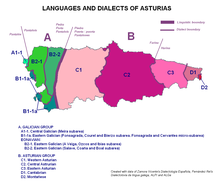
The only official language in Asturias isSpanish.TheAsturian language,also known as Bable, is also spoken, and is protected by law (Ley 1/1998, de 23 de marzo, de uso y promoción del bable/asturiano— "Law 1/1998, of 23 March, of Use and Promotion of Bable/Asturian" ). It is sometimes used by the Asturiancivil service.In the western part of Asturias,Eonavianis also spoken, and its promotion also falls under the responsibility of Law 1/1998. Whether Eonavian is adialect continuumor a variety ofGalician language,however, is a subject of debate, and its use in the Asturian Administration is minor compared to the use of the Asturian language. Within Asturias, there is an ongoing process to establishplace namesin Asturian and Eonavian dialects.
Religion[edit]
In 2019, theCentre for Sociological Researchcarried a study showing the population of Asturias was 65.2%Catholic(25.1% practicing), 13.5%agnostic,and 12.8%atheist.[21]
Politics[edit]
The organisation and political structure of Asturias is governed by theStatute of Autonomy of the Principality of Asturias,in force since 30 January 1982. According to the Statute, the institutional bodies of the Principality of Asturias are three: theCouncil of Government,theGeneral JuntaandPresident.The form of government of the Principality isParliament:The General Junta is thelegislatureto choose, on behalf of the Asturian people, the President of the Principality of Asturias. The President is also the one of the Council of Government, the head ofexecutive power,and politically answerable to the General Junta.
The functions of the General Junta are the approval of budgets, and the direction and control of the action of the Council of Government. It is composed of 45 deputies, elected for four years through the universal suffrage within a system proportional representation that the allocation of deputies is based on D'Hondt method.
Results of the elections to the General Junta[edit]
| Deputies in General Junta since 1983 | |||||||||
|---|---|---|---|---|---|---|---|---|---|
| Election | Distribution | President | |||||||
| 1983 |
|
Pedro de Silva(PSOE) | |||||||
| 1987 |
| ||||||||
| 1991 |
|
Juan Luis Rodríguez-Vigil(PSOE) Antonio Trevín(PSOE) | |||||||
| 1995 |
|
Sergio Marqués(PP/URAS) | |||||||
| 1999 |
|
Vicente Álvarez Areces(PSOE) | |||||||
| 2003 |
| ||||||||
| 2007 |
| ||||||||
| 2011 |
|
Francisco Álvarez-Cascos(FAC) | |||||||
| 2012 |
|
Javier Fernández(PSOE) | |||||||
| 2015 |
| ||||||||
| 2019 |
|
Adrián Barbón(PSOE) | |||||||
| 2023 |
| ||||||||
Economy[edit]



For centuries, the backbone of the Asturian economy wasagricultureandfishing.Milkproduction and its derivatives was also traditional, but its big development was a byproduct of the economic expansion of the late 1960s. Nowadays, products from the dairy cooperative Central Lechera Asturiana are being commercialised all over Spain.
The main regional industry in modern times, however, wascoalmining andsteelproduction: in the times of Francisco Franco's dictatorship, it was the centre of Spain's steel industry. The then state-owned ENSIDESA steel company is now part of the privatisedAceralia,now part of theArcelorMittalGroup. The industry created many jobs, which resulted in significant migration from other regions in Spain, mainlyExtremadura,AndalusiaandCastile and León.
The steel industry is now in decline when measured in terms of number of jobs provided, as is the mining. The reasons for the latter are mainly the high costs of production to extract the coal compared to other regions. Regional economic growth is below the broader Spanish rate, though in recent years growth in service industries has helped reduce Asturias's high rate of unemployment. Large out-of-town retail parks have opened near the region's largest cities (Gijón and Oviedo), whilst the ever-present Spanish construction industry appears to continue to thrive.
Asturias has benefited extensively since 1986 fromEuropean Unioninvestment in roads and other essentialinfrastructure,though there has also been some controversy regarding how these funds are spent, for example, on miners' pensions.
TheGross domestic product(GDP) of the autonomous community was 23.3 billion euros in 2018, accounting for 1.9% of Spanish economic output. GDP per capita adjusted for purchasing power was 24,400 euros or 81% of the EU27 average in the same year. The GDP per employee was 98% of the EU average.[22]This makes the region the 10th richest in Spain, a big decrease from the 1970s/1980s - the heyday of the Spanish mining industry, when Asturias was commonly regarded as one of the most prosperous regions in Southern Europe. Asturias has been growing below the Spanish national average since the decline of the mining industry, and grew just 0.82% in 2008, the lowest of all regions in Spain. On the plus side, unemployment in Asturias is below the average of Spain; it stood at 13.7% in 2017.[23]
| Year | 2006 | 2007 | 2008 | 2009 | 2010 | 2011 | 2012 | 2013 | 2014 | 2015 | 2016 | 2017 | 2018 | 2019 | 2020 |
|---|---|---|---|---|---|---|---|---|---|---|---|---|---|---|---|
| Unemployment rate | 9.1% | 8.0% | 10.0% | 14.1% | 16.6% | 18.8% | 23.8% | 22.3% | 20.8% | 20.3% | 14.6% | 14.6% | 12.9% | 13.1% | 13.5% |
Transportation[edit]

Air[edit]
Asturias is served byAsturias International Airport (OVD),40 kilometres (25 miles) from Oviedo, near the northwest coast and the industrial town of Avilés.
Eastern Asturias is also easily accessible fromSantander Airport.Recent improvements introduced in the road network permit flying intoSantanderand later driving into Asturias, which can be entered in less than an hour's drive. The Irish airlineRyanairoperates flights toSantander Airportfrom Frankfurt Hahn, Liverpool, Dublin, Edinburgh, London Stansted and Rome Ciampino.
Sea[edit]
El Musel(the Port of Gijón) is able to receive cruise ships of any size. Companies such as P&O, Swan Hellenic or Hapag Lloyd choose the Port of Gijón every year for their calls in theAtlantic EuropeanCoast. The following areas are available for cruise vessels:
- Moliner quay: 313 m berthing with 14 m draught.
- 7ª Alignment: 326 m with 12 m draught.
- Espigón II. South alignment. 360 m berth with 9 m draught.
These locations allow a high degree of access control, with security guaranteed for both vessels and passengers alike. The city centre is only 4 km (2.5 mi) away and the Port Authority provides dedicated coach connection allowing passengers to take advantage of the cultural,gastronomicand commercial opportunities that Gijón has to offer.
Between 2010 and 2014, the city of Gijón was connected byferrywith the French city ofNantes.[24]This connection was also known as the "sea highway" and it had a frequency of two ferries per day in both directions. The route was cancelled in September 2014.[25]
Train[edit]

Spain's nationalRenferail network also serves Asturias well; trains regularly depart to and from the Spanish interior. Major stops are the regional capital,Oviedo,and the main coastal city,Gijón.Meanwhile, theRenfe Feverail company links the centre of the region with Eastern and Western Asturias. Under theCantabrian Mountains,thePajares Base Tunnelopened for commercial services end of November 2023,[26]introducingAVEhigh speed trains.[27][28]
Bus[edit]
There is also a comprehensive bus service run by theALSAcompany. It linksAvilés,Gijón,OviedoandMiereswithMadridand other major towns, several times a day. These include services toBarcelona,Salamanca,León,Valladolid,A Coruña,Bilbao,Seville,San Sebastián,Paris,BrusselsandNice,to name just a few.
Main sights[edit]
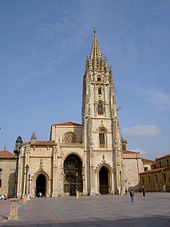

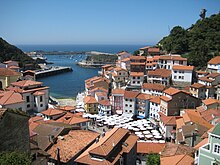
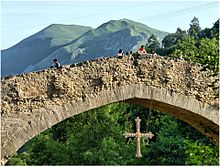
Key attractions[edit]
Oviedois the capital city of Asturias and containsSanta María del NarancoandSan Miguel de Lillo,apre-Romanesquechurch and a palace respectively, which were built by the first Asturian kings on Mount Naranco, to the north of the city (World Heritage Site). In modern architecture, thePalacio de Congresos de Oviedo(orModoo) was designed bySantiago Calatrava.
Gijón,the biggest city of Asturias, is a coastal city known for cultural and sports events,[29][30][31]and a beach tourism centre in northern Spain. It also is known for the traditional Asturian gastronomy and for being an Asturian cider production spot.[citation needed]Museums in the city include theUniversidad Laboral de Gijón,including a modern art museum and theatre.
Avilésis the third largest city in Asturias, where "La villa del adelantado" (as locals call it, in reference ofPedro Menéndez de Avilés) is a meeting point. "Saint Nicholas of Bari" or "Capilla de los Alas" in Romanesque and Romanesque-Gothic style, respectively; Palacio de Balsera, in Modernist style or St. Thomas of Canterbury church (dating from the 13th century) are examples which show the historical patrimony to be found in the city.[citation needed]TheCentro Niemeyer,designed by the Brazilian architectOscar Niemeyer,is an example of contemporary architecture in Asturias.
ThePicos de EuropaNational Park, and other parts of the Asturian mountain range: The Picu Urriellu mountain (2519 m or 8262 ft), also known asEl Naranjo de Bulnes,is a molar-shaped peak which, reputedly, glows orange in the evening sun, hence its name. Weather permitting, it can be viewed from Camarmeña village, near Poncebos, south of Arenas de Cabrales.
The shrine to the Virgin ofCovadongaand the mountain lakes (Los Lagos), nearCangas de Onís:Legend has it that in the 8th century, theVirginblessed Asturian Christian forces with a well-timed signal to attack Spain's Moorish conquerors, thereby taking the invaders by surprise in theBattle of Covadonga.TheReconquistaand eventual unification of all Spain is therefore said to have started in this very location.[32]
The paleolithic art in the caves of Asturias is a declaredWorld Heritage Sitewith thePaleolithic Art of Northern Spain.
Asturias also has examples ofindustrial heritageas a consequence of its industrial activities in the 19th and 20th centuries. It had metallurgical and chemical factories, mines, bridges and railways, including in the towns ofLangreo,MieresandAvilés.
The Asturian coast: especially the beaches in and around the summer resort ofLlanes,the Playa del Silencio nearCudillerofishing village, or the "white" village ofLuarca(Severo Ochoahometown).
Other places of interest[edit]
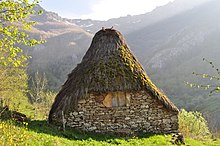
- Ceceda village: east ofOviedoalong the N634 road. Of particular interest in this exemplary settlement are the traditionalhorreos(grain silos), raised on stilts so as to keep field mice from getting at the grain.
- TheDobra River:south ofCangas de Onís,known for its unusual colour.
- Thesenda costera(coastal way) between Pendueles andLlanes:This partly paved nature route takes in some of Asturias' most spectacular coastal scenery, such as the noisybufones(blowholes) and the Playa deBallota.
- Caldoveiro Peak,a scenic mountain hiking area
- The unusual rock formation on the beach at Buelna village: east ofLlanes.Best viewed at low tide.
Culture[edit]
Architecture[edit]
Asturias has a rich artistic legacy that emphasizesRomanesque(Asturias Arts) indigenous architecture with monuments likeSanta María del Naranco,Santa Cristina de LenaandSan Miguel de Lillo.These monuments have a Ramirense Romanesque style (due toRamiro I) orSan Julián de los Prados,known as Santullano (Oviedo) of the Alfonsino pre-Romanesque style (due toAlfonso II), which are all in Oviedo. Other examples of architecture are Villaviciosa's church,San Salvador de Valdediós(commonly known by the Asturians as "Conventín" ), and the church of San Salvador de Priesca. Another example isCabranes'San Julian de Viñón.
TheRomanesquestyle is very present, since all Asturias is crossed by one of theCamino de Santiagoroutes, which highlights theMonastery of San Pedro de Villanueva(nearCangas de Onis), the churches ofSan Esteban de Aramil(Siero),San Juan de Amandi(Villaviciosa) and Santa María de Junco (Ribadesella).
TheGothicstyle is not as abundant, but there are good examples of this style, such as theCathedral of San Salvadorin Oviedo.
TheBaroquestyle is more present by means of palace architecture, with such notable examples as the Palace of Camposagrado and Velarde - the latter seat ofMuseum of Fine Arts of Asturias.The Baroque style stands out in public civil engineering and bridge tolls (Olloniego); the milestones, the chairs or seats present along the road to Madrid and the resort of Caldas de Priorio (Oviedo) building.

In 1985, theUNESCOdeclared the pre-Romanesque monuments and theCathedral of OviedoasWorld Heritage Sites.
In popular architecture, the traditional granaries in Asturias, calledhórreos,are known for their demographic extension and their functional evolution, its basic characteristic being its mobility: it can be easily dismounted and transported to another location. The Panera is the evolution of the hórreo, with examples exceeding 100 square metres (1,076 square feet) of area covered. The purpose of the horreo is to store objects and crops. With the arrival of maize and the beans, they were endowed with exterior corridors and railings for drying the harvests.
Asturias is home to the only architectural work in Spain (as well as the largest in Europe) of the Brazilian architect and disciple ofLe Corbusier;Oscar Niemeyer:theOscar Niemeyer International Cultural Centre.The architectural project was donated to the Principality by the architect, who was awarded thePrince of Asturias Award for the Arts,in the XXV edition of these awards. Niemeyer's project combined several different elements, and projected an open space, a place for education, culture and peace.
In the capital of the Principality stands one of the most representative buildings of modern architecture, thePalace of Congresses of Oviedo,by the Spanish architectSantiago Calatrava,who also awarded the Prince of Asturias of Award for the Arts in 1999.
Special importance has been placed in recent years on the recovery ofindustrial heritagethrough various routes and industrial museums, especially in the central area of the region.
Festivals and holidays[edit]
Some of the most famous festivals in Asturias take place in the small town ofLlanes.These festivals celebrate the important saints and the Virgin Mary adored by the town. The associations that prepare the festivals have a rivalry between them and each year they try to outdo each other with more impressive shows. The three most important are the festival of San Roque (St. Roque) held on the 16th of August, the festival of Nuestra Señora Virgen de La Guia (Our Lady, Virgin Mary, the Guide) held on the 8th of September, and the festival of Santa Maria Magdalena (St. Mary Magdalene) held on the 22nd of July. The Magdalena is well known for its march of logs where boys as young as 3 and men carry logs through the town until they reach the end point and start a large bonfire.

Food and drink[edit]

While Asturias is especially known for itsseafood,the most famous regional dish isfabada asturiana,a rich stew typically made with large whitebeans(fabes), shoulder ofpork(lacón), black pudding (morcilla), and spicysausage(chorizo).
Applegroves foster the production of the region's traditional alcoholic drink, a naturalcider(sidra). Since it is natural and bottled without gas, it produces a weak carbonation, and when Asturian cider is served, it is poured in a particular way,el escanciado:the bottle is held above the head allowing for a long vertical pour, causing the cider to be aerated as it splashes into the glass below. After drinking most of the content, it is customary to splash a little out onto the ground, as a way to clean the glass of anyleesfor the next serving. Traditionally, the same glass is refilled and passed around, with everyone drinking from it in turn.
Asturiancheeses,especiallyCabrales,are also eaten throughout Spain and beyond; Asturias is often called "the land of cheeses" (el país de los quesos).
Sport[edit]
Asturias has two main football teams:Sporting de GijónandReal Oviedo,which have played over 35 seasons inLa Liga.Other current notable sports teams areOviedo CB(basketball) andAB Gijón Jovellanos(handball).
Racing driverFernando Alonsois a two-timeFormula Oneworld champion, two-timeLe Manswinner andFIA World Endurancewinner. He races with Asturias' flag colours and the Asturian cross on his helmet.[33]CyclistSamuel Sánchezwon a gold at the Olympic games. Football players from Asturias include World Cup winnerDavid Villaas well asQuini,Luis Enrique,Juan Manuel Mata,andSantiago Cazorla,among others.
Literature[edit]
These are some notable people of Asturian Literature:
- Antón de Marirreguera(17th century)
- Gaspar Melchor de Jovellanos(1744–1811)
- Ramón de Campoamor(1817–1901)
- Leopoldo Alas, "Clarín"(1851–1901)
- Armando Palacio Valdés(1853–1938)
- Ramón Pérez de Ayala(1880–1962)
- Alfonso Camín(1890–1982)
- Alejandro Casona(1903–1965)
- Carlos Bousoño(1923-2015)
- Ángel González(1925–2008)
- Corín Tellado(1927–2009)
- Gonzalo Suárez(1934)
- Rafael Reig(1963)
- Aurelio González Ovies(1964)
- Xuan Bello(1965)
- Jorge Moreno(1973)
Music[edit]
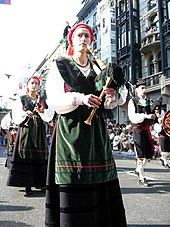

The music of Asturias is varied. The most characteristic instrument in traditional music is theAsturian bagpipe,orGaita asturiana,which has a single drone.[34][35]The bagpipe is often accompanied by the hand drum, whistles and accordion.
In recent years, there has been a resurgence of interest in traditional folk music, and several music ensembles have gained regional and international recognition for their ethnomusicological study and presentation of indigenous Asturian music. Notable examples include traditional pipers such as Xuacu Amieva and Tejedor and fusionist José ÁngelHevia(whose music video[36]provides views of both the gaita and the Asturian landscape), and the groupsLlan de Cubel,Xera,Nuberu and Felpeyu.[37][38][39]Additionally, numerous rock, ska and heavy metal groups have also found relative success within Asturias, many of which incorporate elements of traditional Asturian music into their sound.[40]
Anthem[edit]
The Asturian anthemAsturias, patria querida(Asturias, beloved fatherland), which was a popular song adopted as the region's anthem and formalised byLey 1/1984, de 27 de Abríl.
Orquesta Sinfónica del Principado de Asturias[edit]
TheOrquesta Sinfónica del Principado de Asturiasis the premier orchestra in the Principality of Asturias.[41]It is based in the Auditorio Príncipe Felipe in Oviedo, but also performs in the main concert venues in Gijón and Avilés.Rossen Milanovis the Music Director.[42]
Other[edit]
Asturiasis also the name of the fifth movement of theSuite Española, Op. 47by Spanish composerIsaac Albéniz.Nevertheless, the music has little in common with the region's own folklore. Another famous piece of classical music more authentically inspired by the Asturian musical heritage isNikolai Rimsky-Korsakov'sCapriccio Espagnol,which prominently features a theme from analborada,a dance tune traditionally played to celebrate the rising of the sun.
Notable people[edit]
- Luis Enrique Martínez García,formerFC Barcelonacaptain and manager. he has also been the manager ofSpain national football teamsince July 9, 2018.
- Juan Carreño de Miranda,court painter
- Fernando Alonso,Formula Oneracing driver, 2005 and 2006 world champion
- Leopoldo Alas"Clarín", 19th-century author ofLa Regenta,a seminal work in the Spanish literary canon
- Armando Palacio Valdés,19th and 20th-century novelist and critic
- Francisco Álvarez Cascos,minister in Spain's government 1996–2000 and 2000–2004
- Santi Cazorla,Arsenaland Spain international football player, European Champion 2008 and 2012
- Torcuato Fernández-Miranda,key lawmaker during theSpanish transition to democracy
- Ángel González,major Spanish poet of the 20th century
- Gaspar Melchor de Jovellanos,philosopher, politician,Enlightenmentthinker
- Pedro Rodríguez de Campomanes,statesman, economist, andEnlightenmentwriter
- Agustín Argüelles,liberal politician
- Pedro Menéndez de AvilésSpanish explorer and founder ofSaint Augustine, Florida
- Gonzalo Méndez de Canço,governor of theSpanish Florida(1596-1603)
- Queen Letizia of Spain,a native ofOviedoand wife ofFelipe VI, King of Spain
- Severo Ochoa,1959Nobel Prizewinner for physiology or medicine
- Rafael del Riego,general and liberal politician
- Carmen Polo,wife of Spanish dictator Francisco Franco
- Chechu Rubiera,cyclist
- Victor Manuel,Spanish singer-songwriter
- José Andrés,chef
- Amalia Ulman,artist
- David Villa,New York City FCand Spain international football star, European Champion 2008, World Champion 2010
- Juan Manuel Mata,Manchester United F.C.player, Spain international football star, World Champion 2010 and European Champion 2012
- Michu,formerSwansea CityandRayo Vallecanoplayer
- Xaviel Vilareyo,national poet, writer and musician
- Samuel Sánchez,cyclist, Olympic gold medalist
- Melendi,is a Spanish pop singer-songwriter
- Pablo Carreño,professional tennis player
- Margarita Salas,scientist
- Miguel Díaz-Canel,President of Cuba
-
Pelagius,firstking of Asturias
-
José Andrés, famous chef
-
Queen Letizia, current Queen consort of Spain
-
Fernando Alonso
Events[edit]
- Princess of Asturias Awards
- Asturian Revolution(Asturian History)
- Gijón International Film Festival(Entertainment)
- Avilés International Cinema and Architecture Festival(Entertainment)
See also[edit]
- Arama 36/37:Association for the Recovery of Asturian Military Architecture 1936–1937
- Asturian architecturebetween the years 711 to 925
- Asturian mythology
- Asturcón pony
- Asturian cinema
- Churches in Asturias
- List of oldest church buildings
References[edit]
- ^"BOLETÍN Oficial del Principado de Asturias y de la Provincia"[Official Bulletin of the Principality of Asturias and the Province](PDF)(in Spanish). p. 1479.Archived(PDF)from the original on 17 November 2020.Retrieved2 November2020.
- ^"Cifras oficiales de población resultantes de la revisión del Padrón municipal a 1 de enero"(in Spanish).National Statistics Institute.Archivedfrom the original on 2 March 2021.Retrieved10 January2021.
- ^"Contabilidad Regional de España"(PDF).ine.es.Archived(PDF)from the original on 18 December 2023.Retrieved7 January2024.
- ^"Sub-national HDI – Area Database – Global Data Lab".hdi.globaldatalab.org.Archivedfrom the original on 23 September 2018.Retrieved24 June2023.
- ^The legislation of the Principality of Asturias recognizes the existence of Asturian, committing, in addition, to the promotion of its use, dissemination and teaching:Academia de la Llingua Asturiana (PDF).
- ^"Asturias - Definition of Asturias in English by Oxford Dictionaries".Oxford Dictionaries - English.Archived fromthe originalon 16 January 2017.
- ^"Definition of ASTURIAS".merriam-webster.Archivedfrom the original on 20 June 2018.Retrieved15 January2017.
- ^"Processional Cross, Spanish, ca. 1150–75".Metropolitan Museum of Artwebsite.Archivedfrom the original on 2 June 2023.Retrieved6 December2023.
- ^Oman, Charles(1902).A History of the Peninsular War.Vol. 1. Oxford: Clarendon Press. p. 65.
- ^ab"Fallece Rafael Fernández".La Voz de Asturias.18 December 2010. Archived fromthe originalon 15 July 2011.Retrieved8 January2011.
- ^"Población según número de habitantes. Año: 2022"(in Spanish). SADEI.
- ^"Standard climate values for Oviedo".Agencia Estatal de Meteorología.Archivedfrom the original on 22 July 2015.Retrieved11 April2015.
- ^"Guía resumida del clima en España (1981-2010)".AEMET(in Spanish). 2010. Archived fromthe originalon 17 November 2012.Retrieved17 April2019.
- ^"Valores Climatológicos Normales. Asturias / Gijon".AEMET(in Spanish). Archived fromthe originalon 20 July 2011.Retrieved17 April2019.
- ^"Valores Climatológicos Normales. Asturias Aeropuerto".AEMET.Archivedfrom the original on 7 September 2018.Retrieved17 March2015.
- ^Noack, Rick (23 February 2015)."Map: These will be the Europe's most polluted cities in 2030".The Washington Post.Archivedfrom the original on 23 February 2015.Retrieved2 March2015.
- ^Kiesewetter, G.; Borken-Kleefeld, J.; Schöpp, W.; Heyes, C.; Thunis, P.; Bessagnet, B.; Terrenoire, E.; Fagerli, H.; Nyiri, A.; Amann, M. (13 February 2015)."Modelling Street Level PM10 Concentrations Across Europe: source apportionment and possible futures"(PDF).Atmospheric Chemistry and Physics.15(3). International Institute for Applied Science Systems: 1539–1553.Bibcode:2015ACP....15.1539K.doi:10.5194/acp-15-1539-2015.Archived(PDF)from the original on 19 March 2015.Retrieved2 March2015.
- ^ab"Clean Air - Environment".European Commission.12 February 2019.Archivedfrom the original on 10 March 2015.Retrieved2 March2015.
- ^Alfaro, Mercedes (2010). Regidor, Enrique; Gutiérrez-Fisac, Juan L.; Guevara, David; Jiménez, Antonio José; Tejeda, María Pilar (eds.)."Healthy life expectancies in Spain 1986-2007. Disability-free life expectancy and Life expectancy in good perceived health in Spain and its Autonomous Communities"(PDF).Ministry of Health, Social Policy and Equality.Government of Spain.Archived(PDF)from the original on 4 March 2016.Retrieved23 May2015.
- ^"Eurostat - Tables, Graphs and Maps Interface (TGM) table".Epp.eurostat.ec.europa.eu. 2 March 2015.Archivedfrom the original on 14 April 2014.Retrieved1 August2015.
- ^Centro de Investigaciones Sociológicas(Centre for Sociological Research) (October 2019)."Macrobarómetro de octubre 2019, Banco de datos - Document 'Población con derecho a voto en elecciones generales y residente en España, Principado de Asturias (aut.)"(PDF)(in Spanish). p. 21.Archived(PDF)from the original on 4 February 2020.Retrieved4 February2020.
- ^"Regional GDP per capita ranged from 30% to 263% of the EU average in 2018".Eurostat.Archivedfrom the original on 9 October 2022.Retrieved7 March2020.
- ^"Regional Unemployment by NUTS2 Region".Eurostat.Archivedfrom the original on 5 November 2018.Retrieved13 November2018.
- ^"Inaugurada en Gijón la primera autopista del mar española".La Nueva España(in Spanish). Prensa Ibérica. 16 September 2010.Archivedfrom the original on 28 July 2020.Retrieved1 August2015.
- ^"'Au revoir' a Francia por mar ".El Comercio (Spain)(in Spanish). Grupo Vocento. 22 September 2014.Archivedfrom the original on 16 January 2024.Retrieved30 January2020.
- ^"The AVE arrives in Asturias, 9 ministers later, 13 years late and at a cost of 80 million per kilometer - Kiratas".21 October 2023.Archivedfrom the original on 16 January 2024.Retrieved21 October2023.
- ^"El Gobierno confirma que la Variante para pasajeros y mercancías abrirá en mayo de 2023".Leonoticias(in Spanish). 23 June 2022.Archivedfrom the original on 16 January 2024.Retrieved19 July2022.
- ^"Primer tren de pruebas en la Variante de Pajares tras 17 años de obra y 3.716 millones".La Nueva Crónica(in Spanish). 17 September 2021.Archivedfrom the original on 19 July 2022.Retrieved19 July2022.
- ^SNwebadmin."Semana Negra de Gijón".Semana Negra(in Spanish).Archivedfrom the original on 11 August 2022.Retrieved11 August2022.
- ^"Festival Metrópoli Gijón - Festival de música, cultura y entretenimiento de Gijón".Festival Metrópoli Gijón - Festival de música, cultura y entretenimiento de Gijón.Archivedfrom the original on 14 August 2022.Retrieved11 August2022.
- ^"Gijon | General | ATP Tour | Tenis".ATP Tour.Archivedfrom the original on 11 August 2022.Retrieved11 August2022.
- ^Covadonga, la batalla que cambió la historia de España(in Spanish), 27 May 2022,archivedfrom the original on 11 August 2022,retrieved11 August2022
- ^"Fernando Alonso Me and My Lid".PressReader.1 November 2017.Archivedfrom the original on 26 December 2019.Retrieved30 June2024.
- ^"Practical guide to making pibgyrn by Gerard KilBride".Pibgyrn. Archived fromthe originalon 2 April 2012.Retrieved26 April2010.
- ^Sergio y Pablo Arce."La Gaita Asturiana".Asturies. Archived fromthe originalon 20 April 2010.Retrieved26 April2010.
- ^"Hevia - Busindre Reel (High Quality)".YouTube. 3 June 2009. Archived fromthe originalon 30 October 2021.Retrieved1 August2015.
- ^"FolkWorld Article: Llan de Cubel".Folkworld.de.Archivedfrom the original on 10 January 2017.Retrieved26 April2010.
- ^cranky crow (14 September 2003)."Celtic music of Spain".World Music Central. Archived fromthe originalon 30 June 2009.Retrieved26 April2010.
- ^"CITYFOLK MONTHLY - June 2006".Cityfolk.org. Archived fromthe originalon 6 December 2010.Retrieved26 April2010.
- ^"Asturshop".Asturshop. Archived fromthe originalon 14 April 2010.Retrieved26 April2010.
- ^"Inicio - Orquesta Sinfónica del Principado de Asturias".Ospa.es.Archivedfrom the original on 25 November 2020.Retrieved1 August2015.
- ^Elaine Schmidt."Rossen Milanov".Rossenmilanov.net. Archived fromthe originalon 29 June 2015.Retrieved1 August2015.
Bibliography[edit]
- Bowen-Jones, H. and W.B. Fisher.Spain: An Introductory Geography.New York: Praeger, 1966.
- Dresner, Denise, ed.Guide to the World.Phoenix: Oryx Press, 1998. S.v. "Asturias"
- Encyclopedia Americana.Danbury: Grolier, 2002. S.v. "Asturias"
- Merriam-Webster's Geographical Dictionary.Springfield: Merriam-Webster, 1997. S.v. "Asturias"




